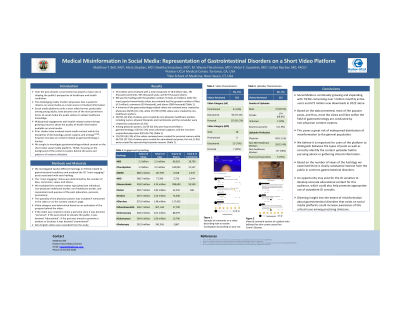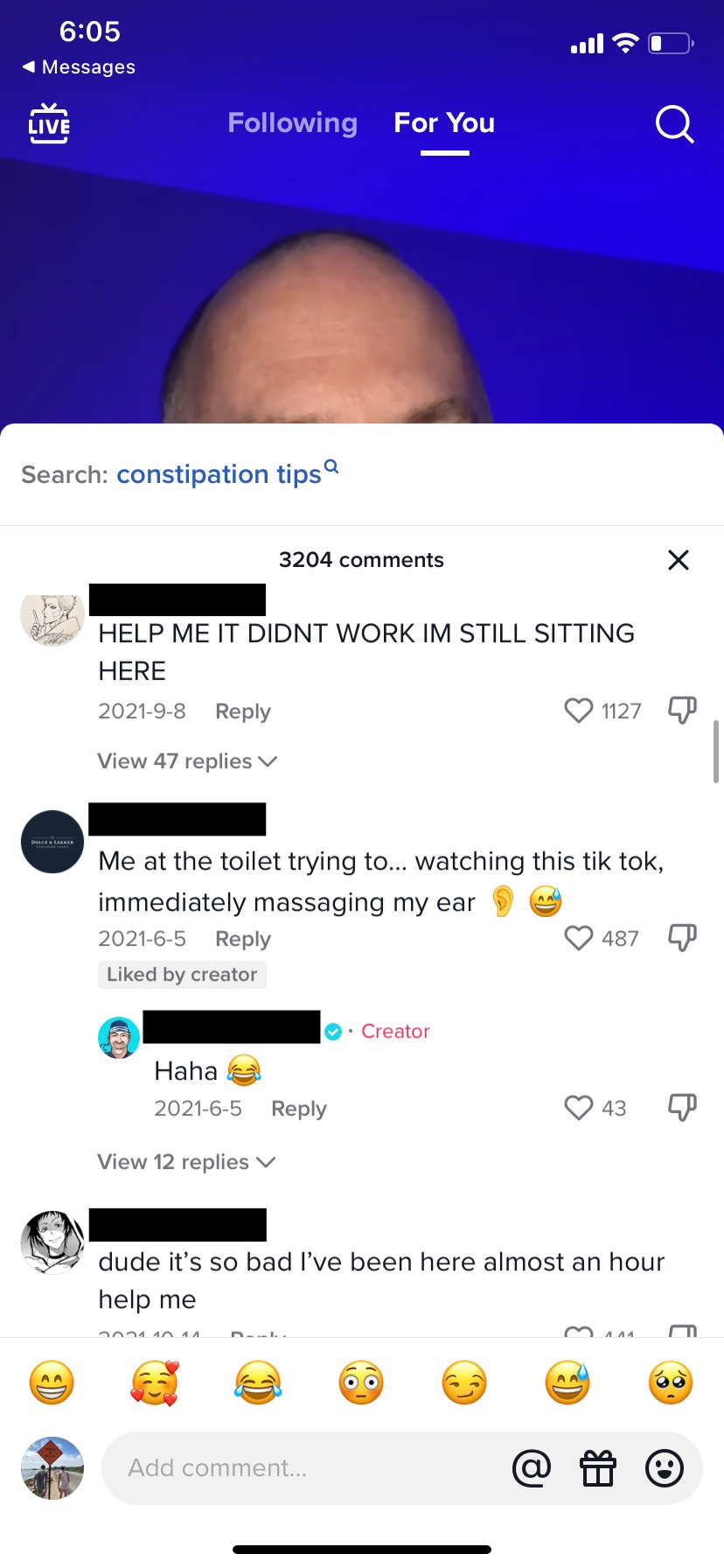Tuesday Poster Session
Category: Practice Management
P4049 - Medical Misinformation in Social Media: Representation of Gastrointestinal Disorders on a Short Video Platform
Tuesday, October 24, 2023
10:30 AM - 4:00 PM PT
Location: Exhibit Hall

Has Audio

Matthew T. Bell, MD
Harbor-UCLA Medical Center
Torrance, CA
Presenting Author(s)
Matthew T. Bell, MD1, Alicia Stephan, BS2, Neetika Srivastava, MD1, Michael Wayne Fleischman, MD1, Viktor E. Eysselein, MD3, Sofiya Reicher, MD, FACG1
1Harbor-UCLA Medical Center, Torrance, CA; 2Yale School of Medicine, New Haven, CT; 3Harbor UCLA Medical Center, Torrance, CA
Introduction: Over the past decade, social media has played a major role in shaping the public’s perspective of healthcare and health conditions. The challenging reality modern physicians face is patients’ reliance on social media as a main source of medical information. Social media platform with a short video format has recently grown in popularity and has more than 1 billion users. Widespread engagement with health-related content brings growing concerns about the quality of health information available on social media. We sought to investigate gastroenterology-related content on the short video social media platform focusing on the background of the content creators behind the posts and patterns of content utilization.
Methods: We investigated twelve different TikTok hashtags related to gastrointestinal conditions and analyzed the 20 “most engaging” posts associated with each hashtag. The “most engaging” status is determined by the application’s internal algorithm based on the number of “likes, comments, views, and shares,” and posts of this status are featured on platform’s “top” page. We evaluated the content creator type (physician individual, non-physician healthcare worker, non-healthcare worker, and corporation) and purpose of the post (education, personal, promotion).
Results: 253 videos were reviewed with a total composite of 18.6 billion likes, 191 thousand comments, 935 thousand saves, and 927 thousand shares. #IBS was the hashtag with the greatest number of views (2.2 billion), while videos on hemorrhoids had the greatest number of likes (4.3 million), comments (59 thousand), and shares (288 thousand) (Table). Most videos 177/253 (70%) were created by non-healthcare workers, while only 28/253 (11.1%) were posted by physicians; most of the physicians were GI 16/28 (57.1%) and colorectal surgeons 5/28 (17.9%). Among physician-created videos, 21/28 (75%) were created for educational reasons and the rest were created for personal reasons. Representative comments on videos we encountered are highlighted in the Figure.
Discussion: Our study demonstrates substantial interest from the public in common gastrointestinal disorders. Most of the popular posts, and thus most the views and likes within the field of gastroenterology, are conducted by non-physicians, leading to the potential spread of misleading content to the general population. There is a need for clinicians to develop accurate educational content for this audience, which could improve patient outreach.

Disclosures:
Matthew T. Bell, MD1, Alicia Stephan, BS2, Neetika Srivastava, MD1, Michael Wayne Fleischman, MD1, Viktor E. Eysselein, MD3, Sofiya Reicher, MD, FACG1. P4049 - Medical Misinformation in Social Media: Representation of Gastrointestinal Disorders on a Short Video Platform, ACG 2023 Annual Scientific Meeting Abstracts. Vancouver, BC, Canada: American College of Gastroenterology.
1Harbor-UCLA Medical Center, Torrance, CA; 2Yale School of Medicine, New Haven, CT; 3Harbor UCLA Medical Center, Torrance, CA
Introduction: Over the past decade, social media has played a major role in shaping the public’s perspective of healthcare and health conditions. The challenging reality modern physicians face is patients’ reliance on social media as a main source of medical information. Social media platform with a short video format has recently grown in popularity and has more than 1 billion users. Widespread engagement with health-related content brings growing concerns about the quality of health information available on social media. We sought to investigate gastroenterology-related content on the short video social media platform focusing on the background of the content creators behind the posts and patterns of content utilization.
Methods: We investigated twelve different TikTok hashtags related to gastrointestinal conditions and analyzed the 20 “most engaging” posts associated with each hashtag. The “most engaging” status is determined by the application’s internal algorithm based on the number of “likes, comments, views, and shares,” and posts of this status are featured on platform’s “top” page. We evaluated the content creator type (physician individual, non-physician healthcare worker, non-healthcare worker, and corporation) and purpose of the post (education, personal, promotion).
Results: 253 videos were reviewed with a total composite of 18.6 billion likes, 191 thousand comments, 935 thousand saves, and 927 thousand shares. #IBS was the hashtag with the greatest number of views (2.2 billion), while videos on hemorrhoids had the greatest number of likes (4.3 million), comments (59 thousand), and shares (288 thousand) (Table). Most videos 177/253 (70%) were created by non-healthcare workers, while only 28/253 (11.1%) were posted by physicians; most of the physicians were GI 16/28 (57.1%) and colorectal surgeons 5/28 (17.9%). Among physician-created videos, 21/28 (75%) were created for educational reasons and the rest were created for personal reasons. Representative comments on videos we encountered are highlighted in the Figure.
Discussion: Our study demonstrates substantial interest from the public in common gastrointestinal disorders. Most of the popular posts, and thus most the views and likes within the field of gastroenterology, are conducted by non-physicians, leading to the potential spread of misleading content to the general population. There is a need for clinicians to develop accurate educational content for this audience, which could improve patient outreach.

Figure: Top comments on a typical GI-related short video post
Disclosures:
Matthew Bell indicated no relevant financial relationships.
Alicia Stephan indicated no relevant financial relationships.
Neetika Srivastava indicated no relevant financial relationships.
Michael Wayne Fleischman indicated no relevant financial relationships.
Viktor Eysselein indicated no relevant financial relationships.
Sofiya Reicher indicated no relevant financial relationships.
Matthew T. Bell, MD1, Alicia Stephan, BS2, Neetika Srivastava, MD1, Michael Wayne Fleischman, MD1, Viktor E. Eysselein, MD3, Sofiya Reicher, MD, FACG1. P4049 - Medical Misinformation in Social Media: Representation of Gastrointestinal Disorders on a Short Video Platform, ACG 2023 Annual Scientific Meeting Abstracts. Vancouver, BC, Canada: American College of Gastroenterology.
